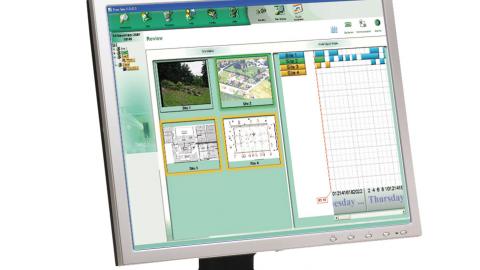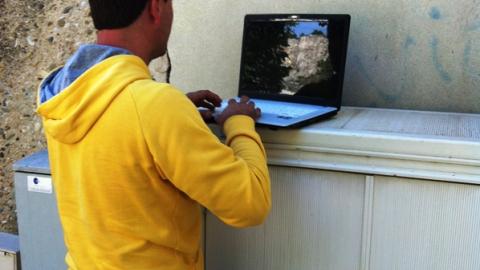Situated in the heart of the Forest of Chantilly, the training centre places at the disposal of the elite of the horse racing world the use of 4 training areas spread over about 2,000 hectares, comprising 120 hectares of grass tracks and 120 kilometres of sand trails.

We went along to the Chantilly Equestrian Training Centre on a fine October morning, where we met Mr. Denis Lemarié, head of compliance at Rain Bird®. Two thousand eight hundred horses are trained there every day, including some of the best race horses in Europe. Some of them are true champions and will race in different parts of the world. The filly that has just won the 2013 Prix de l’Arc de Triomphe at the beginning of October, for example, was trained here.
Mr. Mathieu Vincent, the site manager, met us at the offices of France Galop. “There are almost 3,000 horses being trained in Chantilly every day of the year, involving 1,000 riders and 110 trainers. The site, the largest equestrian training centre in the world, requires a meticulous maintenance programme, which is carried out by a large number of permanent and temporary staff”, continued Mr. Mathieu Vincent.
“Chantilly has developed because it is the first equestrian centre to have an installed irrigation system”, added Mr. David Paul, who is in charge of site maintenance, “The total water consumption of the site was initially about 500,000 m3 per year, which is quite a lot. There is an increasing need to save on water and make irrigation management easier”. Five years ago, those in charge of the site decided to equip the racecourse, the Les Aigles training facility and then the Coye-la-Forêt training ground with a central control system, thus allowing consumption to be reduced to about 400,000 m3 per year. These works were carried out by the companies SIREV and CCA PERROT. “However, there are now three central control systems on the same site, which is quite rare”, stated Mr. Lemarié from the company Rain Bird® (2 Site Control ™ and 1 Stratus ™ LT).
The Les Aigles training ground
Mr. David Paul went out on to the Les Aigles training ground with us, where the horses are trained every morning. Les Aigles has 220 hectares of tracks, which includes 70 ha of turf, 33 km of sand tracks, 4 km of tracks with obstacles and jumps and one 2-km artificial sand and fibre track.
We then arrived at the main 90-metre wide circular grass track. About a dozen horses are resting with their stablelads before going off for a gallop on the sand tracks a little further on. Being constant companions, the stable-lads ride the horses for which they are responsible every morning. One stable lad generally handles four horses and a horse is out training for about one and a half hours each day, according to the programme set by the trainer. In the afternoon, the horses rest in the stables located near the training centres. The stable-lads come back to feed them in the evening.
A little further on, in the middle of the turf track, we catch sight of the irrigation boom systems on travelling carts. These irrigation booms, hand made and fitted with a gun-type sprinkler every 25 metres, are moved along the grass tracks of 60 to 90 metres in width, applying irrigation water as they go.
In fact, these tracks are too wide to be irrigated by traditional sprinklers. “They are irrigated in the spring and summer, two to three times a week, so as to maintain the level of the available soil water reserve, or even a little more often to ensure that the ground is soft and the horses don’t get injured”, explained David Paul. Generally, when the grass is mown it is left quite tall, between 10 and 12 cm, allowing the turf to retain moisture. Mr. Paul continued: “The central control system does not cover this part of the ground, so we still water by hand”. A little further on, we see five or six people filling in the holes in the grass track left by the horses’ hoofs. The turf must be impeccable for the next session.
We then head off to the long straight galloping tracks, laid down in soft sand and measuring 2,000 metres in length and 30 metres wide; these tracks running through the forest where the racehorses are trained. “The horses are trained every day on sand tracks. It is only for the last few training sessions before the race that they are allowed onto the turf tracks” explained Mr. Paul. A group of thoroughbreds gallop past us and the spectacle is magnificent. A few minutes later, a tractor-mounted set of harrows levels out the track to make it passable for the next group of horses.
“70% of the water is used to irrigate the sand tracks”
More than 70% of the irrigation water consumed on the Les Aigles training ground is used to irrigate the sand tracks. These tracks, where horses train daily, must be watered every day to settle the dust.
We can see the impact sprinklers along the Gouvieux straight, surrounded by tyres to prevent the horses injuring themselves. There is a sprinkler every 18 metres, making a total of about 100 sprinklers to irrigate a track that is 1,800 metres in length. The sprinklers are managed by a Rain Bird® central control system. “The central control system schedules the irrigation; only one employee is involved in irrigation, keeping an eye on the system from his vehicle to ensure that there are no leaks or blocked sprinklers”, continued Mr. Paul. “Initially, the site employees were rather reluctant to use the central control system, but now they won’t go back to the old one for anything in the world”.
Moving on, we come to a straight row of water reservoirs and an artificial sand track, with rather special features. Made of a mixture of silica sand, rubber and polymers, the synthetic sand composition enables the site to do without irrigation completely. Moreover, this type of track has the advantage of being usable when it freezes. In fact, the product is mixed with oil, which makes the sand waterproof. Each training ground is equipped with one or two tracks like these, requiring very little maintenance.
Alongside the “piste des réservoirs”, there are four large 500 m3 irrigation water storage facilities. “Previously we used to pump from the river but changed to using the groundwater” Mr. Paul explains. “Two bore holes were dug and pipes were laid in the forest to extract and convey the groundwater to the storage areas”. The site operators stopped pumping from the river because the level was going down each year and riverside residents began to complain. Furthermore, the silty river water used to block the pipes.
Further on again, there is a sand track that is only used in the event of rain. “The main advantage of the Chantilly site is its very large surface area and variety of tracks, adapted to every type of weather condition”, explained David Paul.
The racecourse
The Chantilly racecourse hosts 42 meetings each year, including two major events for which it has become famous, the Prix de Diane Hermès and Prix du Jockey Club. Furthermore, the site is open for training once a week, every Tuesday.
Running alongside the château and Royal Stables, the site is absolutely stunning. It has a grass track and a synthetic sand/fibre track. “The grass track has Rain Bird® impact sprinklers linked to the Site Control™ central control system” explained Mr. Lemarié. The ground is watered two to three times per week between June and September, as well as 48 hours before races to give the water time to soak into the ground. The track is probed with a penetrometer so as to get as close as possible to the right quantity of water required. It is important for the ground to be very damp. In fact, the horses are high-performance athletes with fragile limbs, so, to prevent them getting injured, the ground must be as soft as possible.
The central control system allows for the irrigation times to be managed and considerable savings to be made on water, with the added benefit of having a perfectly uniform surface; in fact, previously the sprinklers used to be left on for 25 minutes instead of 20 minutes, and there used to be variations in the turf. In summer, a team of 18 to 20 people managed the irrigation of the centre. Taking into account the sizeable financial stakes and the demand on the trainers, every detail is important as a race horse can be worth several million euros.
The racecourse is currently irrigated with water from the river Nonette, pumped into the chateau moat. However, work to the value of 1.5 million euros is due to commence very soon in order to be able to draw water from the aquifer, as is the case at the Les Aigles training ground. After having invested in an irrigation system with central control, those in charge of the site are now investing in the water resource.


